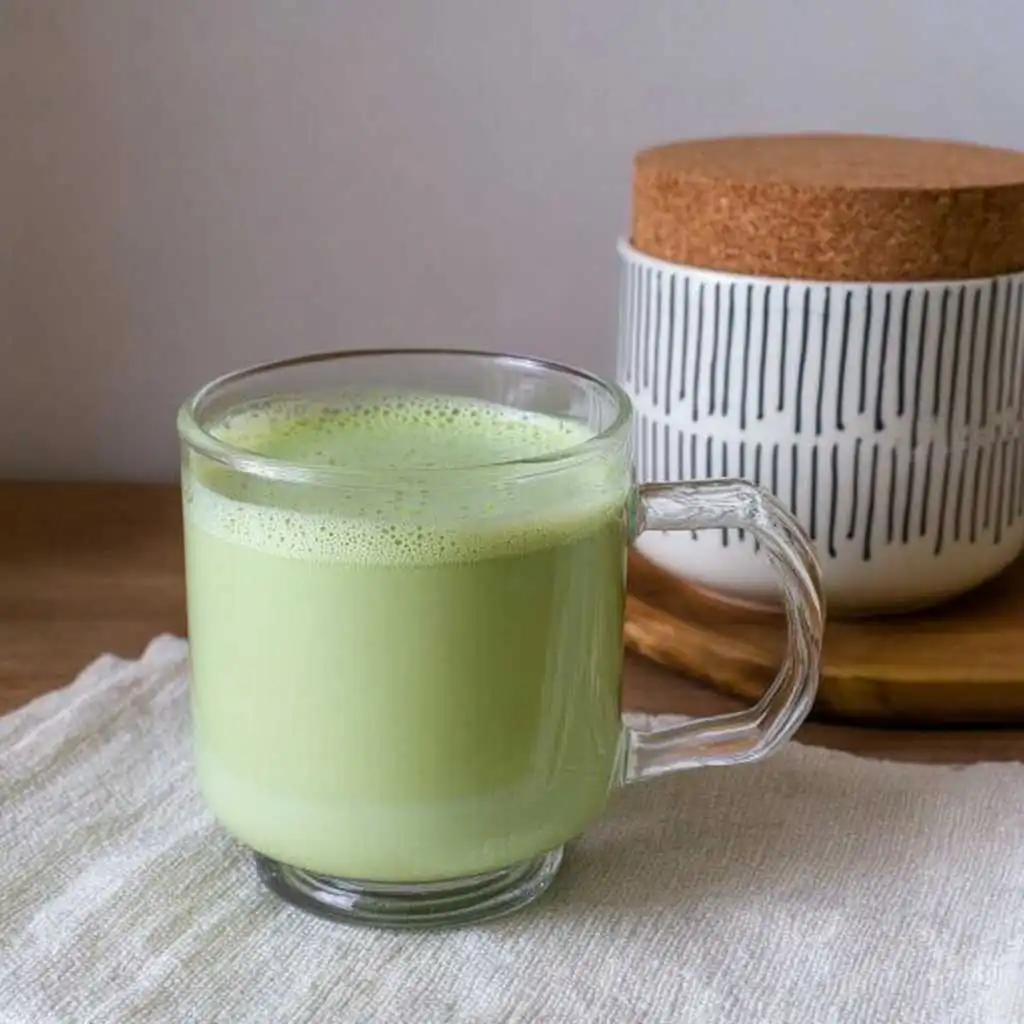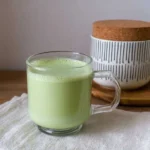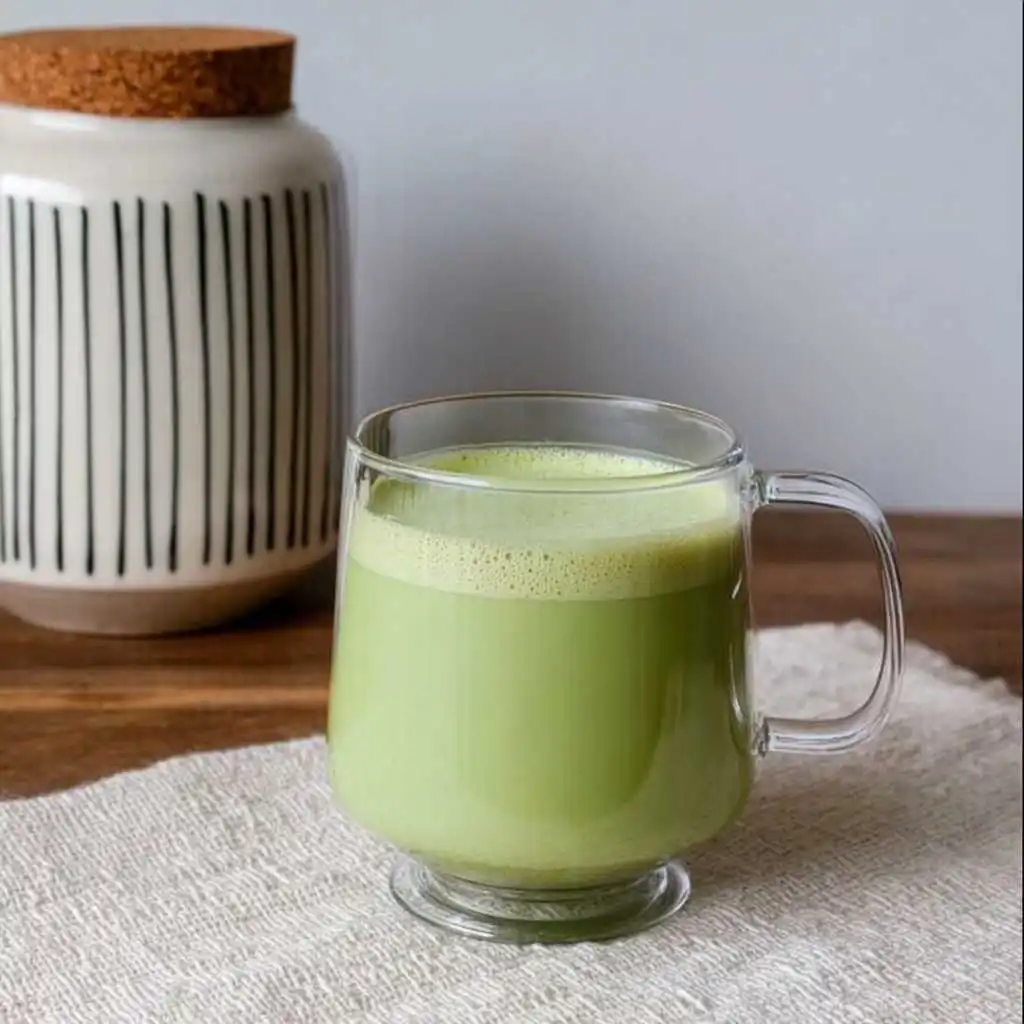
Matcha latte calories can be surprisingly high if you’re not paying attention to the milk and sweeteners used. In this guide, we’ll explore where those calories come from, how different milk types impact the total, and whether a matcha latte can actually support your weight-loss goals. You’ll learn how to craft a lighter version at home and make smarter choices when ordering at your favorite café. By understanding exactly what goes into your matcha, you can enjoy every sip with more confidence—and fewer calories.
Table of Contents

Matcha Latte Calories: How to Enjoy a Low-Calorie, Delicious Matcha Latte
- Total Time: 7 minutes
- Yield: 1 serving
Description
This low-calorie matcha latte is creamy, energizing, and easy to customize. Made with just a few simple ingredients, it’s the perfect healthy alternative to high-sugar coffeehouse drinks. Enjoy it hot or iced any time of day!
Ingredients
Ingredients:
▢ ½ to 1 teaspoon matcha powder (culinary or ceremonial grade)
▢ ¼ cup hot water (not boiling; around 175°F / 80°C)
▢ ¼ cup coconut milk (or any milk of choice, warmed)
▢ 1–2 teaspoons maple syrup, honey, or a few drops of stevia (optional)
Instructions
Instructions:
Whisk the Matcha: In a small bowl or mug, combine matcha powder with hot water. Whisk using a bamboo whisk or milk frother until smooth and frothy.
Heat the Milk: Warm the milk of your choice in a saucepan or microwave. Avoid boiling.
Combine: Pour the warm milk into the whisked matcha. Stir or froth again for a creamy blend.
Sweeten (Optional): Add your desired sweetener and stir well. Adjust to taste.
Serve: Pour into your favorite mug and enjoy immediately!
- Prep Time: 5 minutes
- Cook Time: 2 minutes
- Category: Beverages
- Method: Whisking & Steaming
- Cuisine: Japanese-inspired
Nutrition
- Calories: 45–60 kcal
- Sugar: 2g
- Sodium: 10–25mg (depends on milk)
- Fat: 4g
- Saturated Fat: 3g
- Unsaturated Fat: 1g
- Carbohydrates: 5g
- Fiber: 1g
- Protein: 1g
- Cholesterol: 0mg
Keywords: Coconut milk, maple syrup, matcha powder, hot water, Almond milk, ice
Understanding matcha latte calories
Why matcha lattes aren’t always low-calorie
Most people are surprised to learn that matcha latte calories come more from the mix-ins than the matcha itself. Matcha powder is incredibly light—just 5 calories per half teaspoon. The moment you add milk, though, things change. One cup of 2% dairy milk adds roughly 120 calories, while whole milk pushes that closer to 150. Unsweetened almond milk still contributes roughly 30 to 50 calories per cup, though the exact number varies by brand and formulation.
Sweeteners? That’s where matcha latte calories really climb. Unsweetened almond milk still contributes roughly 30 to 50 calories per cup, though the exact number varies by brand and formulation.
Sweeteners and serving size matter more than you think
You don’t have to skip your favorite drink. Just control what goes into it. Large portions combined with sweeteners are the main reason matcha latte calories can quickly increase. Ordering a 16-ounce latte with sweetened coconut milk and vanilla syrup might deliver more sugar than a soda.
At home, it’s easy to reduce matcha latte calories. Start with ½ teaspoon of matcha, blend it with hot water, then add ¼ cup unsweetened coconut milk. Skip the syrup or swap in stevia. Want more tips? Try our How to Make a Matcha Latte Iced .
How many calories in different matcha latte types?
When people ask how many matcha latte calories they’re actually drinking, the answer depends heavily on what kind of milk is used. From dairy to plant-based options, each type adds a different amount of energy to your cup—and it’s usually more than you’d expect.
Dairy-based matcha latte calories
Using regular dairy milk gives you that creamy texture but also contributes the most to matcha latte calories. An 8-ounce cup made with 2% milk typically has between 120 and 150 calories. If you use whole milk, that number goes even higher—around 150 to 180 calories. Larger lattes, especially those from cafés, can easily top 250 calories once sweeteners are added.
Flavored syrups or extra scoops of matcha powder push the numbers up even more. It’s not unusual for some café-style lattes to reach 300 calories or more, depending on the portion size and ingredients. This is why many people think of matcha lattes as indulgent when they’re made with traditional milk.
Plant-based milk comparisons
If you’re trying to lower your matcha latte calories, switching to plant-based milk makes a big difference. Unsweetened almond milk is one of the lightest options, adding just 50 to 70 calories per cup. Coconut milk ranges from 95 to 140 depending on whether it’s sweetened. Oat milk, especially the creamier “barista” versions, lands between 120 and 160 calories.
All of these numbers can vary slightly depending on the brand, but the trend is clear: plant-based milks often offer a gentler calorie count, especially when you skip added sugars. If you’re watching your intake but still want your daily matcha fix, choosing a lighter milk base is one of the easiest ways to manage your matcha latte calories.
Can matcha latte calories fit into a weight-loss plan?
Drinking matcha has become a go-to habit for many health-conscious people, and it’s easy to see why. But if you’re wondering whether matcha latte calories make or break your weight-loss goals, the answer depends on how you prepare your drink—and how often you have it.
Matcha may support fat-burning and metabolism
Matcha contains catechins, most notably EGCG, which are known for supporting fat oxidation. Combined with caffeine, these compounds can help your body burn slightly more calories throughout the day. Studies suggest that green tea and matcha may increase metabolism during exercise and even improve endurance. So if you’re pairing your matcha latte with a workout, you might notice a small boost in energy and fat-burning potential.
However, matcha isn’t a magic solution. The benefits are subtle and build over time. A few lattes won’t cancel out an unbalanced diet or lack of activity. Still, incorporating matcha into your daily routine as a replacement for sugary drinks is a smart move.
When matcha latte calories help—or hurt
On its own, matcha is nearly calorie-free. But when you turn it into a creamy latte, calories can sneak in. That’s why it’s important to think about what you’re adding. Unsweetened almond or coconut milk keeps your matcha latte calories low, usually under 100. Add sweetened milk and syrups, and you might be drinking closer to 250.
If you’re trying to lose weight, a homemade matcha latte with unsweetened milk and no added sugar can be a satisfying, low-calorie drink. Just keep portions in check and use it to replace—not add to—your daily intake. Done right, matcha latte calories can fit into your weight-loss plan without guilt or guesswork.
Tips to lower matcha latte calories without losing flavor

If you love matcha lattes but worry about the calories, there are simple ways to enjoy this vibrant drink while keeping your calorie count low.
Choose lower-calorie milks and unsweetened options
Switching your milk choice can make a big difference in matcha latte calories. Unsweetened almond milk and coconut milk usually contain fewer calories than dairy or sweetened plant milks. Opting for these can cut your drink’s calorie content by half or more. Also, avoid flavored or sweetened milks that often add hidden sugars. Using just a small amount of milk with hot water and matcha powder creates a creamy texture without packing in calories.
Control portion size and reduce sweeteners
Many café matcha lattes come in large sizes with added syrups or sugar. Using smaller cups and limiting or skipping sweeteners drastically lowers matcha latte calories. You can swap sugar or maple syrup for natural calorie-free sweeteners like stevia or monk fruit to keep your drink tasty but light. Making your matcha latte at home gives you full control over ingredients and portion sizes, helping you manage calories without compromising flavor.
Try starting with ½ teaspoon of matcha powder mixed with ¼ cup of hot water, then adding ¼ cup of your preferred low-calorie milk. Sweeten just to taste, or enjoy it plain to experience the natural earthy flavor. These tweaks keep your matcha latte calories in check and make this healthy drink part of your everyday routine.
Conclusion
Knowing how matcha latte calories add up allows you to enjoy this flavorful drink while staying mindful of your intake. The majority of calories come from the type of milk and sweeteners used, rather than the matcha powder itself. Choosing lower-calorie milk options such as unsweetened almond or coconut milk and reducing added sugars can keep your latte satisfying yet light. Whether you’re drinking matcha to support weight management or simply for its taste and benefits, being aware of your matcha latte calories helps you make smarter choices without sacrificing enjoyment.
For more recipes follow me in Facebook
Frequently Asked Questions About Matcha Latte Calories
How many calories are in a matcha latte?
The calorie content of a matcha latte depends mostly on the milk and any sweeteners you add. Matcha powder itself contains very few calories, typically only a small amount per serving. But once you mix in milk—especially whole milk or sweetened plant milks—and sugar or syrup, the calories can quickly rise, often reaching between 100 and 300 calories per cup.
Is a matcha latte good for weight loss?
Carefully prepared matcha lattes can be a helpful part of a weight-loss plan. Using low-calorie milk options and avoiding added sugars helps keep calories down. Matcha itself contains antioxidants and caffeine that may slightly boost metabolism, but overall weight loss depends on your total diet and lifestyle habits.
Why do matcha lattes have so many calories?
Most of the calories in matcha lattes come from the milk and sweeteners rather than the matcha powder. Full-fat dairy, sweetened nut milks, syrups, and large portion sizes all contribute to increasing the calorie count, turning what could be a light drink into a high-calorie treat.
How many calories are in a matcha latte made with regular milk?
A typical 8-ounce matcha latte prepared with 2% dairy milk usually has between 120 and 150 calories. If you use whole milk, the calories go up to approximately 150 to 180. Adding sugar or syrups will add even more calories to the drink.
